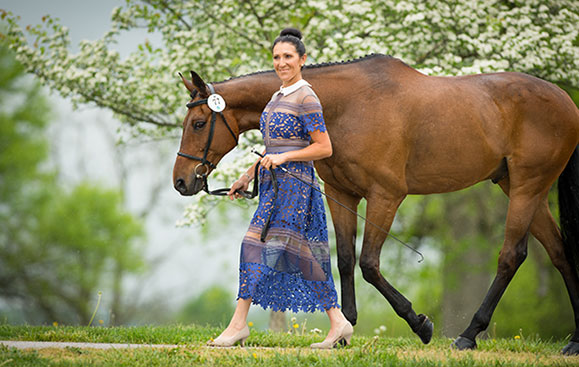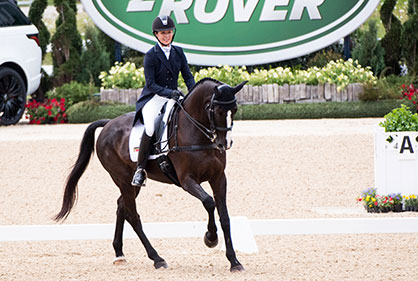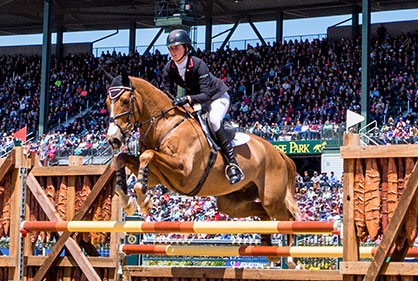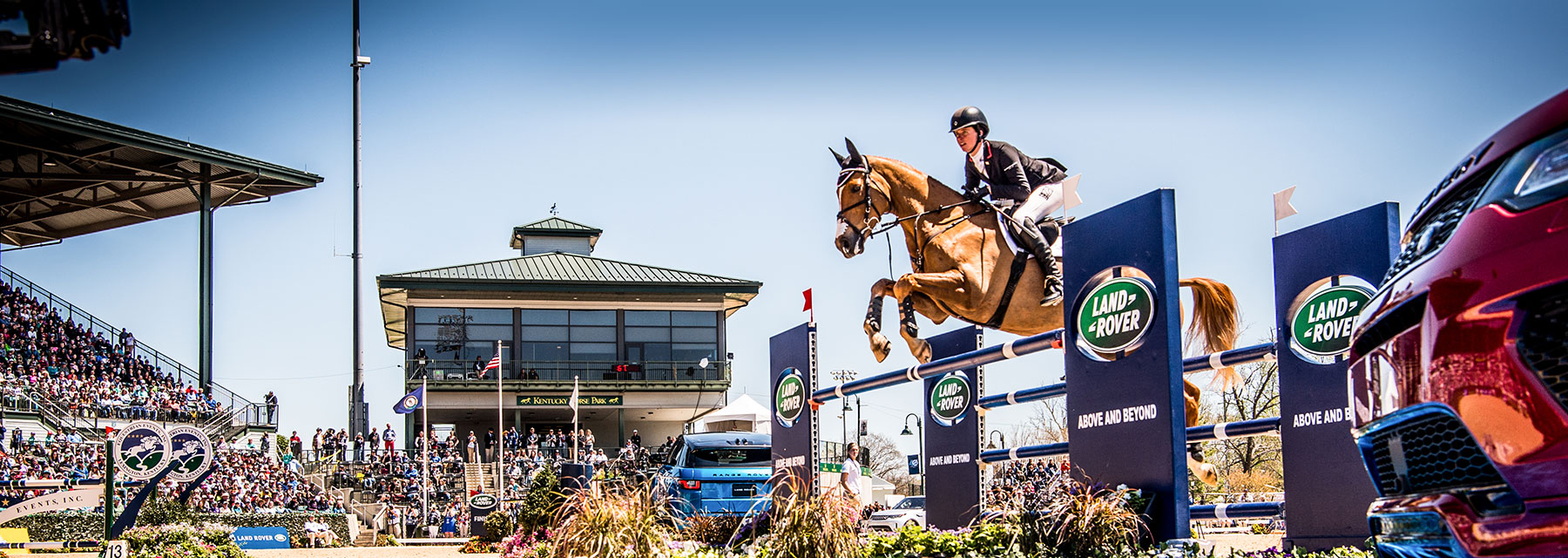Eventing’s Elite Equine Showdown
LRK3DE: A Demanding Test of Physical Stamina, Mental Acuity and Confidence, the 2022 Land Rover Kentucky Three-Day Event Boasts CCI5*-L Status
Upwards of 80,000 equestrian enthusiasts will once again stream through the gates of the Kentucky Horse Park in Lexington, Kentucky, to watch the top horses and riders in a three-day eventing battle over a long weekend of gritty equestrian sport at its very best. Known in eventing circles as the “The Best Weekend All Year,” the Land Rover Kentucky Three-Day Event (LRK3DE) will take place April 28 – May 1, 2022.
The LRK3DE has the exclusivity of being the only five-star three-day event offered in the Western Hemisphere. The ultra-competitive event brings together the world’s best eventing horse and rider combinations to vie for $400,000 in prize money. It is a leg of the Rolex Grand Slam of Eventing that awards $350,000 to any rider who wins all three inclusive five-star events in succession: The Land Rover Kentucky Three-Day Event, the Mitsubishi Motors Badminton Horse Trials and the Land Rover Burghley Horse Trials. The Grand Slam has only been achieved by two riders, Pippa Funnell (GBR) and Michael Jung (GER), since its inception in 1999. As the United States’ premier event, the LRK3DE serves as the Land Rover/ USEF National CCI5*-L Championship for the American riders as well.
Newly crowned a CCI5*-L as of January 1, 2019, by the Fédération Équestre Internationale (FEI), the international governing body of equestrian sport, the LRK3DE takes its place amongst select company. There are only five other five-star events in the world including Badminton and Burghley in the United Kingdom, Luhmuhlen in Germany, Pau in France and Adelaide in Australia.
At the 1974 World Championships hosted in Burghley, England, Bruce Davidson and the United States Equestrian Team won Individual and Team Gold earning the right for the United States to host the next World Championships four years later. Originally known as the World Three-Day Event Championships, it was held for the first time at the, then brand-new, Kentucky Horse Park in September of 1978 to uproarious welcome. That year, horses and riders from Canada won the Team Gold Medal and Individual World Champion Bruce Davidson retained the world title for the United States, riding the magnificent American Thoroughbred, Might Tango. This inaugural event produced by the non-profit charitable Kentucky corporation Equestrian Events, Inc. (EEI) had more than 170,000 spectators and added more than $4 million to the local economy. It was broadcast worldwide, as well as nationally on CBS.
The unprecedented success of the event spurred the EEI to establish it as an annual affair that has evolved into the world-renowned Kentucky Three-Day Event, with the mission to support the development of horses and riders at the highest level and to ensure the competitiveness of the United States in international competition. In 1998, after years of planning, the United States Equestrian Team held the country’s first and world’s third annual four-star competition at the Kentucky Horse Park. This CCI**** event has continued annually up until this year when it received the new five-star designation — the pinnacle status of the FEI's system and an event on par with the Olympics.
Today, the event is broadcast worldwide in 18 languages with an estimated current annual economic impact to be $14.2 million, per a study conducted at the University of Kentucky. Now in its 41st year, the Kentucky Three-Day Event continues to be a thrilling competition featuring eventing’s elite horse and rider combinations from across the nation and around the world and is used as a qualifier for the Olympic Games, World Championships and the World Equestrian Games. Visitors to the event not only experience three-day eventing at its very finest but also enjoy an atmosphere unlike typical horse shows as it caters to fans with fun that includes music, tailgating, course walks with Olympic veterans, shopping and breed demonstrations. Equine enthusiasts representing all 50 states, more than a dozen countries and all walks of equestrian life flock to Kentucky to bear witness to perhaps what is best described as the equestrian triathlon — the formidable combination of dressage, cross-country and show jumping.
“This is the only 5***** in the country,” points out Caroline Martin, 2018 Morven Park International CIC3* winner and Top Under 25 Rider in North America. “The atmosphere and the amount of people in the stadium is incredible. The atmosphere at Kentucky makes this event so different from the rest. Our horses are not used to the crowds that show up in the stadium on dressage. On cross-country day, it is jam-packed. The course is around 12 minutes long, and you have been training all season for this event. On show jumping day, the horses can be a bit tired from the cross-country the day before and are not used to jumping that big. You don’t have that atmosphere really anywhere else in the world. It takes years and years of practice to prepare for the Land Rover Kentucky Three-Day Event.”
“The only way to know that you have a five-star horse is when you cross the finish lines of the cross-country. Until then, all the prep in the world can only get you there. Heart and grit have to pull you both across the finish!”
— Laine Ashker, USEA AEC Gold Cup Champion & Platinum Performance® Client since 2011

Laine Ashker preparing to jog Anthony Patch at the 2016 Rolex Kentucky Three-Day Event during the initial vet check. Laine was voted the NoelleFloyd.com 2018 Stylish Equestrian of the Year.
PHOTO BY SHANNON BRINKMAN
Three Phases of the LRK3DE
The event commences following an initial veterinary check where riders jog their horses for soundness. Dressage is the first phase, followed by cross-country with competition culminating in the show jumping arena.
Dressage
At the Land Rover Kentucky Three-Day Event, dressage takes place over the first two days of competition, Thursday and Friday, due to the number of entries. Dressage, akin to equestrian ballet, is the first phase of competition consisting of an exact sequence of movements in an enclosed arena. Judges are seated down centerline at C outside of the arena and look for balance, rhythm, suppleness, elasticity, self-carriage and most importantly, the cooperation between horse and rider. This phase is extremely challenging in itself, compounded by the fact that event horses are incredibly fit and capable of galloping a cross country-course the next day in time. Asking them to also demonstrate the ability to focus and perform precise movements in a graceful, relaxed and calculated manner possesses a high level of difficulty
The movements of dressage are the basis for both the cross-country and show jumping phases since it develops the strength and balance to carry out the rest of the phases competently. The dressage test at the Kentucky Three-Day Event contains many of the same movements that are seen at the United States Dressage Federation Third Level, such as half-pass at trot, shoulder-in, travers, collected, medium and extended gaits, single flying changes and counter canter. Grand Prix movements such as piaffe and passage are not incorporated into the dressage phase of eventing.
The dressage test is made up of pre-determined movements. Each movement in the test is scored on a scale from 0 to 10, with a score of 10 being the highest possible mark for a set movement. If one movement is performed poorly, it is still possible for the horse and rider combination to receive a good overall score if the remaining movements are very well executed. The marks are added together and errors are deducted to result in a final score, which will carry over into the next two phases.
Cross-Country
The iconic cross-country phase of the three-day event is thrilling and easily enjoyed by equestrian enthusiasts from any discipline or background. For many horse lovers, the cross-country day of the LRK3DE is the very best day of the best weekend all year. Excellent physique coupled with courage are musthaves for horses competing at this level of competition. The cross-country phase can consist of dozens of obstacles and over 40 jumping efforts covering several miles of track. The fences typically consist of solidly built, natural elements, such as logs or stone walls and various other obstacles such as ponds or streams, ditches, drops and banks. Combinations are included that offer several jumping efforts based on objects naturally occurring in the countryside. Venues that host higher level cross-country phases will usually also have more unnatural but still solidly built jumps such as the beloved wooden squirrel and duck at the Kentucky Horse Park.
For refusals at a jump, penalties will be added to the base dressage score from the previous day. Four refusals total or three at a single fence will result in elimination of horse and rider, meaning they can no longer participate in the competition. A horse and rider combination can also be eliminated for going off course or jumping in the incorrect direction or order. If a horse falls (the horse’s shoulder and hindquarter touch the ground), mandatory retirement is taken and the horse is not allowed to participate further in the competition. If riders fall off their horses, they are eliminated. The penalties for disobediences on cross-country are weighted severely relative to the other phases of competition to emphasize the importance of courage, endurance and athleticism. Fitness is of the utmost importance as the time allowed will require a strong gallop throughout the cross-country course with time penalties accumulating outside of the set time frame.
Show Jumping
The third and final phase on Sunday is show jumping. This phase tests the technical jumping skills of horse and rider, including suppleness, obedience, fitness and athleticism. Up to 20 fences are set in an arena, which typically include brightly-colored poles and standards. Unlike cross-country fences, show jumping obstacles fall down readily, resulting in faults per obstacle knocked down. Penalties accrue in show jumping with a knockdown of fences. Obstacles are considered knocked down if any part of the height is lowered. Penalties are also earned from a refusal, run-out, circle or any movement backward. A second refusal, fall of horse or rider and going off course results in elimination. Speed is also a factor as one-time penalty accumulates each second over the time allowed. The show jumping phase is also a major test of the physical fitness, longevity and stamina of the horse and rider as it is held the day after the physically and mentally-depleting cross-country phase. The champion of the Land Rover Kentucky Three-Day Event is the horse and rider combination with the fewest penalties following the completion of all three phases of competition.
3 Phases of the Land Rover Kentucky 3-Day Event
Day 1 - Dressage
Consisting of an exact sequence of movements in an enclosed arena. Judges are seated down centerline at C outside of the arena and look for balance, rhythm, suppleness, elasticity, self-carriage and most importantly the cooperation between horse and rider.

Jennifer McFall in the dressage phase at the 2018 Land Rover Kentucky Three-Day Event. Jen began competing High Times as a five-year old in Novice and has trained him up through the 5* level. Jennifer has been a Platinum client since 2010.
PHOTO BY SHANNON BRINKMAN
Day 2 - Cross-Country
Consists of dozens of obstacles and over 40 jumping efforts covering several miles of track. The fences typically consist of solidly built, natural elements, such as logs or stone walls and various other obstacles such as ponds or streams, ditches, drops and banks.

Crediting her incredible equine partners — Livingstone, Gin and Juice and Jollybo, Hawley Bennett-Awad Hawley Bennett-Awad is always a fan favorite competitor in the prestigious Land Rover Kentucky Three-Day Event. Hawley has been a Platinum client since 2014.
PHOTO BY SHERRY STEWART
Day 3 - Show Jumping
This phase tests the technical jumping skills of horse and rider, including suppleness, obedience, fitness and athleticism. Up to 20 fences are set in an arena, which typically include brightly-colored poles and standards.

Caroline Martin and Spring Easy in the show jumping phase. At the 2018 Land Rover Kentucky Three-Day Event, Caroline had a broken foot and was still one of only 10 riders to jump clear in the show jumping phase. Caroline has been a Platinum client since 2016.
PHOTO BY SHANNON BRINKMAN
Notable Kentucky 3-Day Event Champions
Bruce Davidson (USA):
Won the Kentucky Three-Day Event 6 times (1978, 1983, 1984, 1988, 1989, 1993) when it was then known as the Eventing World Championships, Advanced Three-Day CCI and Advanced Three-Day CCI***, respectively.
Pippa Funnell (GBR):
Won the Rolex Kentucky Three-Day Event in 2003 on Primmore’s Pride as the first leg of her eventual Grand Slam victory that year.
Kim Severson (USA):
Achieved back-to-back wins on Winsome Adante in 2004 and 2005.
William Fox-Pitt (GBR):
Won the Kentucky Three-Day Event three times on different horses: Cool Mountain (2010), Parklane Hawk (2012) and Bay My Hero (2014).
Michael Jung (GER):
The most decorated three-day eventer ever, Jung won the Kentucky Three-Day Event three years in a row (2015, 2016, 2017) on FischerRocana FST. He is the first eventing rider to hold the Olympic, World and European titles simultaneously and one of two riders to win the $350,000 Rolex Grand Slam of Eventing.
Oliver Townsend (GBR):
Currently the #1 ranked eventer in the world and the 2018 Land Rover Kentucky Three-Day Event winner aboard Cooley Master Class.
Eventing Shorthand for LRK3DE
What is a CCI*****?
With only six hosted annually around the world, these events are the most prestigious and difficult tests of horse and rider offered in the sport. Dressage is a test in itself as it asks extremely fit horses ready to bear down on four miles of cross-country at a clip to first demonstrate attention, grace and focus through a rigorous and calculated dance sequence. The cross-country course typically contains between 40 to 45 jumping efforts, over several miles (6,270 – 6,840 meters) of terrain taken on at a gallop with speeds of 570 meters/minute or more than 21 miles per hour. Five-star cross-country tracks are technical and demanding, particularly as they will boast maxed out dimensions of 3’11” fence heights, over 6’ spreads and allow 6’6” drops. These elite cross-country courses reward not only fine-tuned preparation and athleticism but incredible bravery and trust as well. Show jumping courses are set to 1.30 m (about 4’3”) and will ask for more precision and yet another display of fitness following just an overnight rest to recover from the physically and mentally-demanding cross-country phase. Elite five-star events clearly create sophisticated tests of physical stamina but also mental acuity and confidence as well. These most difficult courses have the smallest margin for error and ask the most out of every horse and rider combination.
“Any competition at this level is a great feat that is the culmination of the hard work and determination of a horse and rider and the team/village behind them,” says Jennifer McFall, FEI CCI4* Eventer. “Even the most talented, toughest and competitive pairs can find the arduous path to a 5***** nearly impossible.... This show brings in the best horses and riders from all around the world to compete for top prize money. You will not find a better exhibition of talent and horsemanship than in Kentucky in April!”
“What makes Kentucky so different is that it’s the pinnacle of the hard work you and your horse have achieved over many, many years. To be entered alone is an honor, let alone finish!”
— Laine Ashker, USEA AEC Gold Cup Champion & Platinum Performance® Client since 2011
What is a CCI versus a CIC?
Concours Complet International (CCI)
Events held as a CCI (Concours Complet International) are held over a course of five days and are officially regarded as an International Three-Day Event. They are held in a dressage, cross-country, show jumping format. The first day is the first horse inspection and trot up, followed by two days of dressage, a day of cross-country with a final horse inspection and trot up, followed by show jumping. This is more testing to compete in as horses must be managed overnight, where naturally they will become quite stiff from muscle fatigue after the cross-country, which will affect show jumping performance. There is a huge fitness and preparation difference between CCI and CIC.
Concours International Combiné (CIC)
A CIC (Concours International Combiné) is regarded as an International One-Day Event, even though it is usually held over multiple days. These events are governed by and held under FEI rules. Typically, there are 1.5 to 2 days of dressage, dependent on the number of entries and a horse inspection/trot up, then one day of show jumping and cross-country. During larger events, it is not uncommon to have the show jumping and cross-country phases on separate days. Unlike the CCI format, the event is held as dressage, show jumping then cross-country with only one trot up. Cross-country courses are shorter in distance and time than CCI courses. CIC events are less testing than CCI and are generally regarded as preparatory runs.
What is the Head of the Lake at LRK3DE?
The Head of the Lake is an iconic Kentucky Three-Day Event water jump on the cross-country course and a fan favorite. It is a challenging combination water jump where competitors face a huge drop into the water followed by several options and combinations through the water itself. Competitors then typically must negotiate a fence back out to dry land before galloping away to finish the course.

by Emily Smith, MS,
Platinum Performance®
